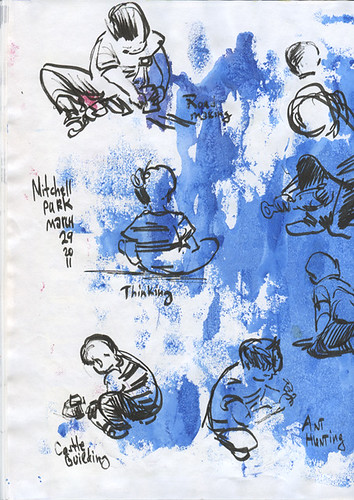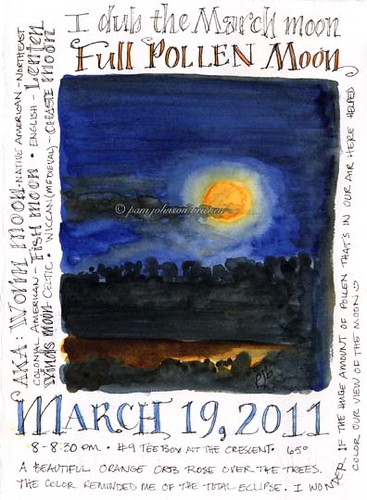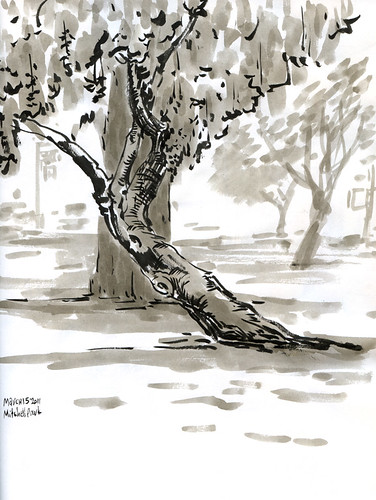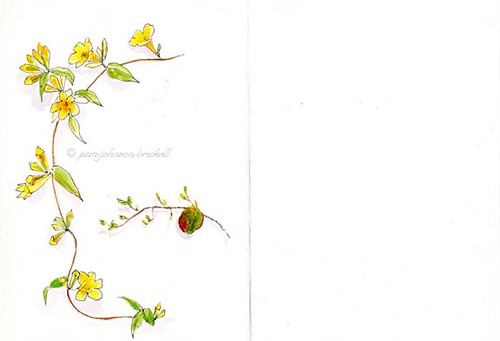The way I moved around this page was very quick and fragmented - head here - leg there. Some things (like a figure on the very top_ came in one piece. Others were completed in several parts. I think using this pre-painted background makes this page a little more interesting for me to work through by providing some hint in composition. Sometimes I make these pre-painted pages as a way to get through a sketching block. And sometimes these backgrounds make me work in a new way and help with the same thing - try them out! :)
Pages
Thursday, March 31, 2011
Tuesday, March 29, 2011
It's Time To Celebrate Spring!
Not only is Spring finally getting underway, the Spring Schedule for Imaginary Trips has been posted!
We'll be going on "An Imaginary Visit to the Garden!" starting Thursday, April 14th and the Artful Journaling classes, Foundations and Explorations are starting on Tuesday, April 19th!
Come and join me, Laure Ferlita in the fun! For more information, you can visit the links above or visit the i•Trav•e•logue here.
Sunday, March 27, 2011
International Fake Journal Month Is Almost Here!
It's almost April and that means International Fake Journal Month (IFJM) is about to begin.
IFJM is the celebration of fake journals. Every year in April I encourage people to keep fake journals for the month. (April is the obvious choice right?)
If you don't know what a Fake Journal is, let me explain: A fake journal is a journal that is kept by a character of your creation. It is kept day, by day, as any other journal would be. The entries are dated with the date that it actually is when when it was written, i.e., today's journal entry would be marked 3/27/2011. What is fake about the journal is the fact that the character is not you, and the character is not writing about your life.
You can read more about Fake journals, as well as Historical Fake Journals and Faux Journals at the Official International Fake Journal Blog.
Each year I set up a prize drawing for participants and you'll find information on how to enter the 2011 contests in the right hand column of that blog under "Contests for 2011."
I've kept fake journals off and on my entire life. It seemed a natural outgrowth of my daily journal practice and my slightly odd sense of humor.
And I have found the practice informative and helpful, in many of the same ways that I have found my real journal keeping to be.
Just some of the ways fake journaling can benefit you include: new strategies to shut up your internal critic; new proficiencies with media; discovery of creative ruts and ways to get around them; and of course play.
Creative play is always good. It helps us get back to our real work.
If the idea of a fake journal intrigues you I invite you to check out the links to the Official International Fake Journal Blog and read more about the process. You'll also be able to view a couple of my past fake journals, as well as the fake journals of past participants. You might concoct a way to take a vacation from your journal WITH your journal, or explore issues of interest in a new way.
If you are new to journaling (written or visual) I recommend that you not keep a fake journal until you have firmly established your own journaling practice. But in the meantime there is no reason you shouldn't enjoy the posts about fake journaling and be entertained by the work of other artists trying this out.
Most of my posts on fake journaling are really about journaling in general, or rather real journaling—I'm just trying to give you some options, some ways of seeing something from a different angle. Something that you can take back to your regular journal practice to make it deeper and more satisfying because it comes from a place of epiphany.—Roz
Friday, March 25, 2011
Ut oh, what to do?
Laure and Kate had great suggestions but I read those too late, also :) Do we see a pattern here? Ha!
Here's what transpired in journal land:
 |
| Please click images for a large view |
Thursday, March 24, 2011
Full Pollen Moon
My nose has been so close to the grindstone lately I didn't hear about this moon being so special and called, by some, the 'supermoon' - I'm going to have to figure out how to add a note about this on an already full page!
Day Pretties
 |
| Watercolor, Ink and Stamps 3.5 x 8.5 inches Handbook Watercolor Sketchbook |
This page was suppose to sizzle with all that fun, bold yellow pigment, but when I finished (before I added any background) it just didn't have it.
The most obvious fix seemed to be to add a background, but what? I had just created a page with amaryllis (here) and used text as the background and I didn't want to repeat myself. I let the sketchbook sit open on my desk so that I could see it each time I walked by.
Finally, I decided to go with stripes to help emphasis the long stems. As Kate says, "meh." I didn't much like the stripes. So out came the black pen and then I added black stripes. Still didn't like it.
Leaving the book open and continuing to study it, I had about decided it was going to have to live as it was. A little later, I was prowling around in my study on the hunt for an unrelated item when I stumbled across some stamps......and a light bulb came on.
I retrieved my sketchbook and went to work. I used tracing paper as a "shield" and stamped the background. In a few places, I drew in the stamp shape rather than try to cut a shield.
There are things I will do differently next time, but I really had fun with the process and evolution of this piece. Sometimes, we have to get outside of "normal" solutions and reach for something new to make a page successful!
Wednesday, March 23, 2011
My big fat black journal
Theirs are visually arresting books---almost art objects in themselves. They feature well-designed pages and handsome lettering. Often the books themselves are handmade, the paper of good quality.
While there may be entries of a personal nature, they are not so private that no thought is given to the appearance of the page for possible public sharing, even if the sharing is of a limited nature. In general, text and image are both important. The pages themselves may not be pristine. In Roz’s, Kate’s and Danny’s books, there’s lots of experimentation going on and many quick, quick sketches, but the overall effect seems to be of a well-made, nicely designed artifact. (I say ‘seems,’ because I have only seen these journals on line.)
My own illustrated journals, until recently, were different from these. They were more sketchbook than conventional journal, without a strong textual presence.
In those pages, I’ve practiced drawing because I LOVE it and so that I could become better at it. I’ve taught myself how to use watercolor, and, in more conventional journal-writing fashion, I’ve tried to get down on paper, in images, the important events and people in my life.
From the time I was about 8, though, I’ve written in diaries and journals. My sketchbooks were a thing apart from those written records of my life. For the past 6 years, my concentration on drawing and producing my blog Laurelines put an end to my journal keeping.
A few months ago, I turned to writing in a journal again. In taking up journaling once more, I remembered the lessons I learned years ago from the powerful, transformative book, The New Diary by Tristine Rainer. Rainer advocates journaling as a means to communicate with oneself, to develop creativity, to solve problems, to enrich the inner life.
Emphasis is on freedom of expression, expanding consciousness, finding a state of flow ---and getting all of this down on paper any way you can. Well-designed pages? Good paper? Nice lettering? Well, unless you operate that way instinctively, intuitively, with your eyes closed, without censors or brakes... no.
When I restarted my journaling life, I had not planned to include imagery. Or not planned NOT to.
I just bought a big blank book (big enough to allow me to scrawl across a page) with mediocre paper (something that the sketching me would not have been happy about) and started writing.
And images appeared, there, along with the words!
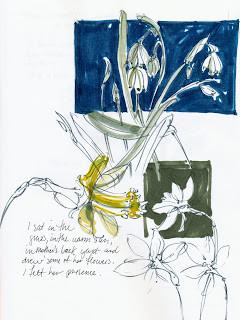
The more the images appeared, the more I gave way to their flow. Now, I can hardly wait to see what will happen next!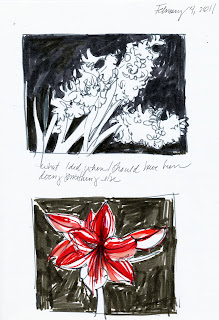
Why I don’t KNOW what will happen next is because this new journal of mine is about process and not product. It’s about communication with the self, not with others.
And it’s about pulling together the various aspects of myself---myself the artist, myself the writer, myself the mother, wife, friend and all the rest... all in one place, between two covers of a regular old, big, black, blank book.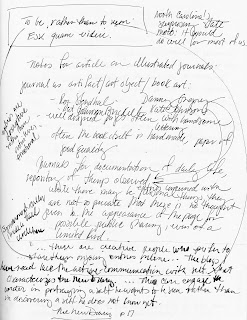
It’s an illustrated journal, but it doesn’t look like Kate’s, or Roz’s, or Danny’s, or Pat’s. It’s rough-hewn, private, with buckled and splattered pages, loaded with crossed-out words and wiggly arrows. It works for me. I write about it here as a way to show there are many ways to make this thing we call an illustrated journal and to say that maybe something LIKE this may work for you, too.
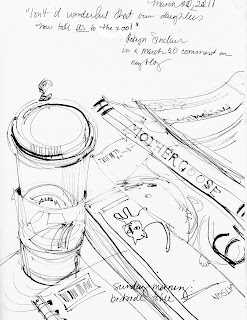
Sketching in public?
 |
| Ask permission! This young man was in my pottery class, and I loved his dreds, so I asked if I could sketch him. FUN. |
 |
| Sketch from a distance...these were quick gesture sketches of my neighbor across the street. He didn't even realize I was practicing! |
Fred Crowley draws in a Panera's, and does a lot from memory. Roz Stendahl sketches among the crowds at the State Fair, Liz Steel does wonderful travel sketches, Laura Frankstone works in cafes and on cruises, Alissa Duke sketches in museums and botanical gardens, all of these with people around.
In fact, many of our correspondents have found ways to work in public. So how do YOU handle it??
Tuesday, March 22, 2011
Finding time...developing the journaling habit!
As we've mentioned here, one of the best ways to find time for journaling is simply to be prepared. It's become a habit with me. If I'm ready--even if it's just to do a simple pencil or ink sketch--it makes it EASY to journal, even in tiny bits of time.
Have your art supplies with you, even if that means a very small, simple set of paints and a waterbrush or two--and of course, your journal.
I've sketched this view more than once--I like it, tucked between the railroad tracks in the distance, our supermarket, and the biggest car dealer in town. A little triangle of country in the midst of town!
I often opt to sketch while Joseph grocery shops...works best for both of us, since I tend to impulse buy and J. reads alllll the labels. Sketching is GOOD!
 |
| This was the little set I was using, but since it's a year later it looks much more used than it does here! |
This time he just had to get a few things, so I knew I didn't have long. I laid in large areas of color to follow the shape of the hills and railroad right-of-way and then later, when I got home, got out my lovely little gold-nibbed dip pen. It's tiny and fits in my travel kit easily. (In order to use it comfortably, I stick that shortie handle in a section of cut-off drinking straw!)
 |
| Joseph found this one online and bought it for me, so I'll have a backup! |
I reconstituted the colors that had dried in my palette, made them a bit more intense, and drew in the details--a suggestion of trees in the background, the mown grass, and a few weeds up close. FUN.
Still later, I added a few notes that will bring this special day back to me.
I seldom do a whole page at once, but add a bit here and there as I have time or inspiration. If I had to search for my materials or hoped to do a whole journal page at once, I'd never get as much done as I do! Bite-size pieces!
Monday, March 21, 2011
Watch for Interview #9--Enrique Flores is up next!
Enrique has long been one of my favorite journal-keeping, world-traveling artists. You may have seen his bold, colorful work on Flickr, as 4ojos, HERE, or on his blog, HERE.
I'm delighted he agreed to be part of our international group of artists in the book and on this blog--Enrique is from Spain, but his journals will take you all over the world.
He has dozens of scanned sketchbooks and journals to drool over, at this link: http://www.4ojos.com/sketchbooks.html and you won't want to miss him on YouTube, where he is acuarelista! He pages through his sketchbooks so you feel as if you are sitting right there beside a good friend...and an inspiring one, too!
Saturday, March 19, 2011
Composite pages for busy days...
Sometimes you only have time for a very-quick sketch or two--sometimes I allow that single sketch to be all that there is on a page, but this is also my JOURNAL, recording what's going on in my life.
Here are three days' worth of sketches and notes...the ongoing studio/office reorganization and the funny things we've turned up (a newspaper clipping from the house blessing here in 1977, old photos, records of payment for paintings sold 30 years ago, royalty reports for back when books sold very nicely, thank you), lunch with friends, the antics of my silly cat, Ellis, and notes about life...
Keely came first, in pencil, at a quick lunch...then the corner of the office a day later, then the cat sketches in the corner, where I had room. Later, because I'm enjoying my Lamy Safari pen, I went over the sketch of Keely in ink to match the rest of the page, and added a touch of white Prismacolor to suggest dimension...it's a fun page that captures a moment in time.
Who knows, it may not be done yet...maybe a little more white...
Sketching Trees
One of great joys in sketching for me is working on trees. I look forward to winter month to work on their skeletons and make lists and maps of trees to draw... I have to admit that by the time I get to that skeleton I very often find it full of leaves ;) But I have fun nonetheless - and would encourage anyone to meet and sketch more trees - they will stand still for you for long periods of time and never utter a word of criticism! :)
Friday, March 18, 2011
Interview #8--Roz Stendahl!
I'm a graphic designer, illustrator, and book artist living in Minneapolis, MN. I came up to Minnesota (the thought of snow didn't scare me off) to attend graduate school (I have an MA in English). After graduation I stayed, still not put off by the snow; and I was in love, with Dick who is an engineer (and he's stuck to Minnesota like a tick in a dog's groin).
I worked at a series of jobs in publishing, until I became a production editor for a company publishing college textbooks. Production editors handle the hiring and supervising of all aspects of a book's journey from manuscript to printed form-copyediting, proofreading, illustration, photography, typesetting, and printing. During my tenure there I discovered that my favorite part of the process was design, so I started doing designs for the books I handled, with my boss' blessing (it saved him money). Eventually I went to work for myself.
I like to have a lot of projects going on at the same time, besides work projects, so I started teaching journaling and book arts classes. I was fortunate to take classes with a truly skilled bookbinder, Denny Ruud. I learned several traditional bindings from him, but more important I learned to think about the book structure, the use of the structure, and the characteristics of the component parts. My own current structures are my experimental departures from traditional bindings. They meet my own sketching and painting needs. I have enjoyed encouraging students to look at their own journaling and sketching needs and requirements to create a book that is most useful to them. I try to teach a couple classes a year to encourage the bookbinding and journaling spark in others. My blog Roz Wound Up grew out of my teaching, replacing a Yahoo list I had for past students.
Also between branching out on my own professionally and 2003 we shared our lives with two Alaskan Malamute bitches-Emma and Dottie. Dogs give us great gifts every day. For an artist one of the greatest gifts is the reality of a live-in life model.
----------------------
And now, on to the interview!
------------------
Q Have you always journaled, and when-and why!--did you start?
A I have always journaled. My mother gave me my first journal/sketchbook when I was 3-1/2 years old and we were on the President Wilson traveling from the Philippines to the US. She wanted to keep me occupied. She told me to go and note things down and sketch. So that's what I did. Or as much as any 3-1/2 year old can. Scribbles which I thought were very important and of course meant something to me. I've had diaries and journal/sketchbooks ever since.
Q What's your favorite medium, can you tell me why?
A Pen and ink with watercolor or gouache washes. I like this medium because it's a great way to sketch-the pen and ink for line and even value shading, and then if you have time, the watercolor or gouache washes for adding color. You can take time to do really detailed pieces this way, or quick thumbnail sketches which you can make color notes on with the paint, to use as references for later paintings.
I like this medium because it is portable. A couple pens and I'm all set-though sometimes I do take my dip pen and a bottle of ink out and about for the ink. I like Staedtler Pigment Liners for my fine line-sketching pens as they are waterproof when dry and also the ink doesn't have a chemical odor like other waterproof pens I've used. I also really love the Pentel Pocket Brush Pen for its bold ink lines which can be thin, fat, dense or dry brush depending on how you wield it. So I can get along with a brush pen, a regular pen (or two of different widths) and then my small watercolor palette and gouache palette-both of which hold 11 colors and are children's palettes that are about 1 x 3/4 inch. I've simply popped out the kid's colors and put in my own from tubes. I use Daniel Smith and M. Graham watercolors in the watercolor palette and Schmincke Gouache and M. Graham Gouache in the gouache palette. I chose those brands because they have quality pigments and because they all re-wet really well. I carry a Niji waterbrush to use with the paints out in the field.
Readers can see my palettes (and read about them) at
http://rozwoundup.typepad.com/roz_wound_up/2008/10/travel-palettes-for-watercolor-and-gouache.html
I think the main reason I use pen, ink, and watercolor or gouache is that they don't smear on the opposite page of a spread.
I used to do a lot of colored pencil in my journals because I couldn't find journals bound with paper compatible with wet media. Colored pencils always smeared over time in my journals and also I was always having to take a large selection of pencils with me out into the field in order to have a range to work with.
Then I started making my own journals and I didn't have to worry about paper issues. I started watercoloring over pencil lines, but something about me prefers using pen and ink. I like the finality of the lines, or rather the boldness. I don't mind that I have to find my way to the line sometimes and have other lines in the image. It's all part of the experience, a record of my seeing of something.
Of course I had those extra lines when sketching with pencil or colored pencil too as I don't erase-but those lines were more muted and easier to cover or fade out.
I will still use graphite or colored pencil for sketching upon occasion and then cover with watercolor washes. The watercolor's gum arabic holds the graphite to the page nicely. But I always end up back with pen and ink. At least if I run out of time I always have the pen and ink and no smudging-if I had sketched in pencil without the watercolor it would smudge.
More and more I care less about smudging-but instead of going back to graphite and colored pencil I find that my growing tolerance for smudged artwork has led me to the brush pen's bold lines covered with Stabilo Tones (which will smudge). (Stabilo Tones are a water-soluble wax pencil that used to be made in a 60 pencil range and now is available in about 12 colors now called Woodys. It's a delight to use and I'm enjoying every last speck of my large set. People interested in working in a similar medium with a large color choice can try out the Caran d'Ache Neocolor II line. They aren't the same in all characteristics so the fun level is a little less, but it's as close as we can get since Stabilo doesn't want to make the full range of Stabilo Tones any more.
If you go to my blog and search under Colored Pencils and Stabilo Tones you'll find lots of articles on how to apply and work with this medium, and it's pretty much transferable to the Caran d'Ache, except the blendability is a bit different (less fun), but you'll get the hang of it.
So that's where I am right now. In 10 years I may be back to graphite and watercolor. Meanwhile in the studio I seem to be veering off further into fluid acrylics. I don't try to control it, I simply follow my nose. I do believe you have to stay with a medium long enough to really explore it, to understand how it works and what applications and situations it works best for. Other than that I'm always experimenting. Odor limits my choices, I have to stay away from any art materials that have either a chemical or strong floral odor. But I still have plenty of choices.
Q What made you start the Daily Dots? How do you feel about them now? [Roz's journal pages about her beloved dog.]
A I almost always have a DAILY project going on for a YEAR at a time. I was working on "The Correspondence Lab" which was a year of writing a letter every day. (I printed special stationery and envelopes with a logo, it was great fun; and I never worried about writing a long letter-just wrote something every day for a year. I did it because I felt that email was killing my correspondence habit!)
Well as "The Correspondence Lab" was winding down I got to thinking what I would do next for a DAILY-year-long project, and of course I looked down at my feet and there was Dottie. I'd been an illustrator since before I got my first dog Emma, and I didn't draw her much, or Dottie at first, just every so often. I regretted not drawing Emma more when she was alive. She died in 1996 and the letter writing project started in 1997 and ended in 1998. My train of thought was "Don't regret not drawing Dottie." So, like most things, two thoughts crash into each other at just the right moment. I knew it would be easy to do the Daily Dots because she was right with me all the time, there was no excuse not to sketch her. So I started right after I finished the last letter for "The Correspondence Lab"-within a couple days. I'd purchased 10 or so Michael Roger Press casebound drawing books that were all covered with linen fabric (I love that sailcloth "color") and off I went. It was always about what I could do in 5 or 10 minutes. In the entire time I was working on the project I only missed about 5 days (maybe less), and those were all because of trips out of town for work. I would draw her the day I left (even if it meant getting up earlier than usual because of my departure time (that's one day taken care of), and I would draw her the day I returned, even if I had been traveling for hours and it was almost midnight! (So that was that day taken care of.) That left only the days I was actually out of town and there were few of those.
I wasn't obsessive about it-dogs have a nice way of being in the moment and that helped me be in the moment as well. And it was always meditative. She was so BEAUTIFUL. Every hair on her was lovely. Even hardened dog owner friends who never say any dog they meet is cute confessed after she died that she was lovely. Emma was striking and handsome-imposing like a lion. Dottie was simply lovely. So every drawing of her was a delight-even when she wasn't cooperating. I was learning patience with the best of teachers. And rewarded with a lot of insight into her as a dog, a presence, and a companion.
Drawing Dottie, paying so much attention to each detail of how her white eyebrows melded down into her muzzle, how her black mask changed over time to gray, how her hair changed over time, and such-it all helped me see her health-to see how she was aging. Even while the project was going on I realized it was one of the most moving experiences I'd have in my life. I had already bonded with this dog through training, through tracking training, and now I was bonding with her through observation in a quiet setting, just being. (Well she was just being, I was sketching like a fiend to finish before she decided to go "be" somewhere else.)
When the first year of the Daily Dots ended (I missed no days that year) I just couldn't stop. There wasn't any reason to stop. So I kept going. July 1, 1998 to January 26, 2003, almost 5 years. The first three years I used those Michael Roger Press casebound sketchbooks with thick drawing paper. I mostly worked in graphite or black pencil (Koh-i-nor's Negro 1, which became Cretacolor's Nero 1; or Derwent Drawing Ivory Black). Then I decided to shake it up a bit. Each new volume was one I bound with a different paper to use with a different medium-one for watercolor pencils, one on Magnani Pescia's blue paper for pencil, one with pen and ink and watercolor wash, and one with pen and ink and gouache of course.
When we got the liver cancer diagnosis I allowed myself to draw her more than one time a day (she only had about 3 months after that diagnosis, which we discovered because of another unrelated operation). I say "allowed" because throughout the project I had to limit myself to one drawing a day, not just because of pacing, but because of the realities of life. We all have work to do. I would have easily spent all my time sketching her. As it was, I filled 43 volumes with drawings of her.
How do I feel about them now? Well every friend knows that if the house is burning they need to go to that shelf, grab those journals, and leave me behind. I'll get out some how!
Seriously, they are a document of observation and attention and love, but not obsessive love. It's the type of love that sees what is. And the daily practice of sketching her taught me a great lesson about love. Ultimately, when it was time for Dottie to die, that daily drawing practice helped me let her go.
It also taught me a lot about what I take for granted in my journal practice (which is also pretty much daily) and in my drawing skills and where I want to go with my art in general. Bottom line, the Daily Dots are about gratitude. I can see that clearly as I look at them now, and could see it clearly in the final months. That gratitude fills me up the way nothing else ever had before.
I made two facsimiles of the journals early on in the project so that I could take samples to classes without taking the original books (because I didn't use fixative in the journals and I didn't want the drawings to be smeared-my students can be hard on my journals). In one of the facsimiles I wrote a little essay in which I summed it up this way: This daily drawing practice has been a tremendous gift. I've learned to see more clearly, look more closely, savor my time with Dottie, and put my life in perspective. I encourage everyone to set up their own daily adventure in observation.
The project really did change my life. My observations at the zoo, my observations whenever I drew changed, improved. The amount I drew increased across the board. I stopped working 14 hour days at the computer without drawing. In other words I learned to slow down and breathe.
In a way I also feel the Daily Dots redeemed me in my own mind. I had not drawn Emma enough and I was honoring her by drawing Dottie. Now when I keep up my daily drawing projects I'm honoring Dottie, but I'm also honoring myself and my perspective on life. I'm taking time to listen and see. This is an odd thing to say because I had been an observer and journal keeper all my life up to and including the time I had dogs and started keeping the Daily Dots. The project created fundamental life changes and I'm grateful for it every day.
It has also given me a way to deal with grief. The project in part was a way to insulate me from the grief of losing Emma and it had the exact opposite effect in that it broke me wide open. It made me love Dot all the more, and ultimately, as I said above, allowed me to accept her passing.
It has also lead me to the rather obnoxious behavior of throwing myself at my friends who have dogs, simply showing up to sketch their dogs. Happily many dogs have enjoyed coming to stay at "Spa Roz"-"where the walks are long and interesting, the treats are plentiful, and all you really have to do in return is nap a bit so she can stare at you quite a lot!"
Q How do you find time to sketch when other people need to do things elsewhere?
A If I see something that I want to sketch I just sketch it. I would love to take more time over things, and sometimes my sketches are very quick and not as "polished" as I would like, or as I am capable of. The point is it is more important for me to get a sketch in my journal (along with other notes) than it is for me to make a polished sketch, so I'm OK with rough pages. And as for the people I travel with or hang out with-well they all know I like to sketch, and most of them do too (or take really fabulous photographs). There is a wonderful accommodation that has happened in my life (and made me again, so very grateful). By showing up and being present and needing to take notes and sketch, I've attracted people to me that are OK with that, enjoy doing it too, push themselves to sketch because I am (that's their learning piece that they've chosen), or allow me the time because I am quick and it's not really disruptive. They know they can sit with me for a moment or two while I sketch something, or they can wander off and we can meet up later. It's all open, and it's all OK. There isn't a lot of ego pushing. I think this is because I have always tried very hard to be quick and also respectful of other people's time and their needs and this has been given back to me.
It really is a seamless process and I talk about this in my classes and try to create this atmosphere for my students when we sketch out in classes so that they can get a taste of it and carry it into their own lives.
As I've said, the people in my life are really interesting. So I simply love hanging out with them and seeing what they like to do and going where they like to go. I can be happy anywhere they want to go because I am with them having fun and I have my journal. So I don't have to have an agenda. (The State Fair is the only time I have an agenda: arrive at 10 a.m., spend three hours in the barns sketching hard; take a one-hour break for food and diversion; return to the barns and sketch hard. There are friends who go to the Fair with me who will meet up with me after all of this is over so we can just be at the Fair!)
[You can see Roz's 2010 MInnesota State Fair Journal HERE
and if you go to Roz's blog and use the search feature you can find tons of posts on the state fair.]
I think if you don't have an agenda and you just draw what presents itself, and if you work quickly, and if you don't make a huge production about it, it just happens. Unfortunately some novice journal keepers do make a big deal about sketching by saying things like "Sigh, I want to sketch this so let's stay here for an hour and I'm going to get all my gear out." We don't have to wonder very hard why people stop going out with them.
So I think it helps to have no agenda and to have interesting friends and travel companions who are strong enough in their own egos and able to self-entertain and engage with the world. And you need to sketch a lot so you can be quick about it; enjoying, at the same time, whatever the result is of those quick sketching moments.
To me it is also important to make a travel journal adaptive to the circumstances of travel. If you are going to be rushing from place to place with other people you need to travel light with few supplies. My Madison journal on my websiteHERE is a perfect example of this type of strategy. I was traveling with 4 people for the first time. I didn't know how long we would stop anywhere. I carried a pen and a pad of sketching paper with me. I also had a rubbing crayon and thin Japanese paper to use for the rubbings. I gathered materials and made notes (on my pad with my sketches) during the day. At night I collaged the various elements together on cards that I had prepainted before leaving home. I tied things together with bits of color added by colored pencil. It worked really well. And when I returned home I made the case to fit the stack of cards I had created.
I think it is also key to have time alone. So when I travel, I typically get up early and sketch something before other folks are even up. Or late in the evenings when people are talking, or maybe watching TV (depending on where we've traveled), I'll sit at a table nearby so I can be companionable, and I'll sketch (and chat if it's appropriate). I'll sketch rocks, local plants, or other items I picked up earlier in the day, of if I'm really lucky and a dog is with us-you get the idea. And at other times, well if I want to sketch my food before I eat it it's just me who's going to get a cold meal, and I can eat pretty quickly so I won't hold people up. It's a combination of adaptation to the circumstances. If you don't make a big deal about it the process is seamless.
Q Does the new blog (OK, not so new, now) enhance your journal keeping, or take time away from it?
A I've found that it takes time away from my WRITTEN journal, since Roz Wound Up is really about the writing, in that I'm writing about my journal pieces, about my paintings, about my enthusiasms (biking, baking, dogs, painting, etc.). This means my written journal has really thinned down. The visual journal has stayed pretty much the same. (I know this because I page my journals and have a yearly total that I can compare to to see what's going on in my life.)
The blog has taken time away from other things however, since I don't let it take away from the visual journal. Those other things include personal projects and painting projects and house related projects-you name it. I started blogging in October 2008 and as I wind down year three, I've toyed with the idea of a brief hiatus to get some pressing deadlines finished. It's also always good for me to look at how my projects fit into my current creative needs, so it's good to take a look at where the blog needs to go in my life. I just wrote a piece about how the blog is pretty much a letter writing substitution for me and so it was very easy for me to make space in my life for it (as I'm a huge fan of letter writing).
We are coming up on International Fake Journal Month (April) and my blog for that starts to demand more time. (I post actively on that blog from March through May of the year.) People can visit that blog at http://officialinternationalfakejournalblog.blogspot.com/
This year I have quite an involved project for IFJM and I know I'll be blogging less in general. I think blogging has reached it's own level in my life. It's a combination, as I said, of letter writing with looking at process. I love to do both. Every time I think I'll just take a haitus I think of 15 things I need to post about during what would be my time off. As long as I enjoy it I'll keep it up, but no more than one post a day. I have to have time away from the computer!
Q Other thoughts? Whatever else you feel is more important, personally, to YOU...
A I say this all the time to students, and I've said it in other interviews, the most important thing to me is that I work in the journal all the time, and that I love messy, ugly pages, and experiments gone wrong. In fact if I don't have a complete disaster every five page spreads or so I really feel I'm not trying, I'm not pushing myself. The journal for me is a place to play and explore and that means every page isn't going to be pretty, but every page is going to be a learning experience for me in some way-otherwise I doubt I would have kept up with it for so long. It's fresh every day I pick it up.
Another part of welcoming "disaster" pages is that the journal is for me. Just me. I'm the audience. This is very important. If the journal were to be something to impress someone else, or communicate with someone else I just don't think I would keep it. To me, the journal, containing all the things I notice and write about and try out, is a document that captures the way my brain works, the way my creativity works. I have pages and pages where I keep swatches from paintings and photos of the progress of paintings. I have notes on why I decide to do X with this artist book binding instead of Y. I have lists on how to cut materials for classes with annotations on why I made certain choices. All those types of things I write down because I want to have them to jog my memory. And they do that sometimes, other times they are never viewed again. Whether I look at the journals or not, just looking at the shelves which hold the more recent volumes (I have to rotate earlier books into storage for space reasons so I have about 10 years worth of books at hand in my work area) makes me feel good about how my brain is functioning, how it is producing, how it is noticing, and how I'm remembering to breathe! And they remind me to be grateful.
--
Thank you, Roz, this was wonderful! I know everyone will enjoy it...
Be sure to visit Roz's website at http://www.rozworks.com
and her terrific blog at http://www.rozwoundup.typepad.com/
Sunday, March 13, 2011
Last night's party--evolving page
Last night we went to a birthday party for a friend...the only place we cold find to sit was near where the children were playing, so of course I grabbed my journal for some quick sketching! They were moving constantly.
This is on tan paper...
You can tell there was no time for anything more than a suggestion of detail...and a few of the sketches were just a line or two as the girls kept moving, hopping up, leaving, coming back, getting a new toy, changing places...
This morning I decided to add some gouache to the most promising one, of young Annabelle at play. I added the first layers with flat, simple colors.
I wanted more detail than I was getting with the waterbrush, so I got out my colored pencils and sharpened them, strengthening values and colors as I went along...
Here's how she turned out when I finished. I may add more to the page, I may not...they DO evolve...
Wednesday, March 9, 2011
Watch for Interview #8--Roz Stendahl is up next!
My friend Roz is a generous, giving, funny, and talented woman, with a thought on just about everything! An avid painter of birds and dogs and State Fair critters, you know whatever she puts in her journal is going to be terrific!
Buried in snow this winter, what did she do but turn it into a charming little 'zine, and sent me a copy.
Roz is an illustrator, a designer, a consummate bookbinder, and has taught workshops on binding books and then using them. (I wish I could take one of her classes--John Payne, one of my journaling/sketchcrawl buddies traveled all the way from Kansas to do so. Envy!)
So watch for her interview, it is chock full of information and inspiration!
Meanwhile, check out her blog at Roz Wound Up and her regular blog, Rozworks!
time for a new journal . . .from Vicky Williamson
. . . another one I bound myself. It's hard to find sturdy cover papers locally. I used a heavy scrapbook paper on this cover but it still seemed like it would wear out long before I finish sketching within its pages.
Kate told me of a neat trick she uses on some journal covers: Future floor wax! Actually I couldn't find any, but Pledge had one that had the Future logo on the label. And it seems to have worked well. Just a bit of shine but it feels much sturdier.
At first the cover was plain, but since I am picking up my new Scottie puppy this coming weekend, I just had to add a bit of Scots to the journal. I'm sure there will be many sketches of her coming . . .
But true to my own tradition, the first pages were palette sketches.
Tuesday, March 8, 2011
Spring's Color Song - I
So many colors popping, so little time....
Join me as I build this journal page. This is the start to my salute to Spring. Journal pages can take many days to complete, especially if you only have to bits and pieces of time. The important thing is to grab any time you get to create, as in the end you will smile with the results :)
Monday, March 7, 2011
A new video on YouTube for quick sketching techniques
I did this for one of my online classes, but decided to share--hope you enjoy it! (I had to shoot it three times, I forgot to turn the camera on the first time...)
Thursday, March 3, 2011
Snow Sketching - 2
The most interesting discovery was use of snow on my sketches. I am posting a couple below - on icicles it's hard to see as I did not press snow too much but you can see it really create a storm on other one :)

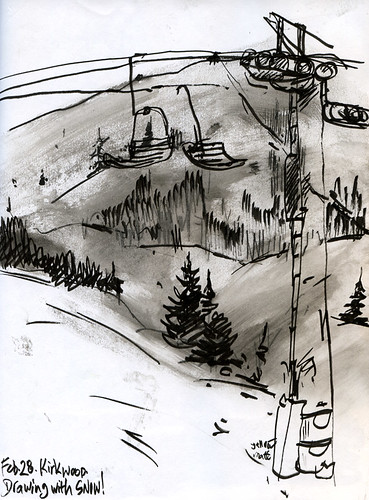
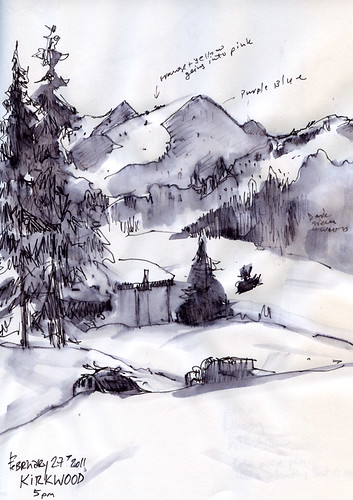
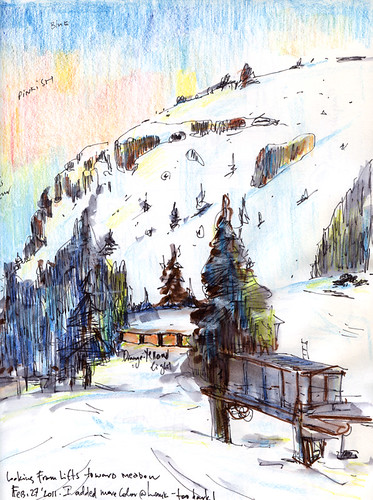
Click on images to see larger versions and some additional comments.
Working with the Weather--art tips!
 |
| A very quick sketch near the library on a cold winter day... |
 | |
| I added color later, from memory, when I had more time. I HAVE had the water freeze in my waterbrushes before, but you can warm and thaw them in your hand if need be. Just don't stay out too long! |
One of the things in our poll at right was dealing with the weather. I find that I sketch in my journal winter and summer, indoors and out, and it's good to be prepared. There's nothing wrong with working from your car or out a window, of course...the important thing is to keep making those records in our journals, to keep observing and celebrating life.
Do what you can on the spot, make notes, add color later, take a quick photo and paste it in...whatever's necessary!
You may have seen correspondent Nina Khashchina's post on Snow Sketching--fun and full of great ideas.
 |
| I always go out on January 1, no matter what...for this one I worked fast with a colored pencil, and added the color, again, later. I'd forgotten water or colored pencils, anyway. |
Some of you may know I offer free art tips on my website, and have for years. (You can find them HERE at upper left--we're up to #112 now, and old ones are archived as PDFs.) Since I've done a couple on working with the weather, I thought you might like to see them!
The first one covers sun, wind, heat and rain, for those of you in warmer climes:
http://www.cathyjohnson.info/tips/tip44.pdf
And you'll find "Sketching on the Spot in Cold Weather here: http://www.cathyjohnson.info/tips/tip84.pdf
Sketching in Nature correspondent Elva Paulson wrote a post about write-in-the-rain paper--you can find it HERE. Looks like fun!
Please, share your OWN favorite tricks for dealing with weather!

